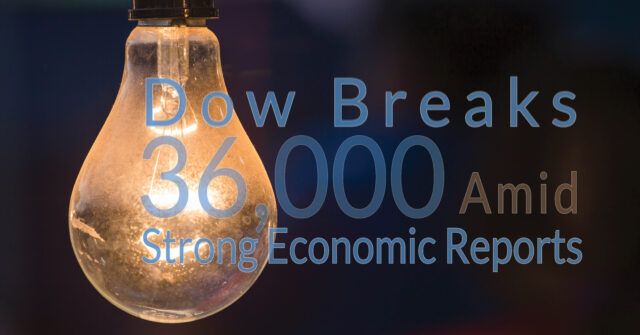Dow Breaks 36,000 Amid Strong Economic Reports

November 5th, 2021
Market bulls celebrated another milestone this week, breaking the 36,000 level for the first time ever. The level first grabbed headlines when the aptly titled “Dow 36,000” hit bookstores in October 1999 during the height of the dot.com boom. In the book, the authors argued the index was undervalued and was poised to rally from its roughly 10,000 level to 36,000 that very year. The prediction was a bit off on the timing of the achievement, however, taking 22 years to hit that level. The index’s performance in the last 1.5 years is particularly notable, rising a staggering 95.40% from its March 2020 trough to Friday’s close. The market’s run has been supported by central banks around the world unleashing an unprecedented amount of fiscal and monetary stimulus to fight Covid. However, the market’s stellar performance could be poised to slow now that the Federal Reserve has announced it will reduce its bond purchases, the first step towards normalizing monetary policy. The move coincides with a healthy U.S. economic backdrop as this week’s jobs, manufacturing, and services posted strong results. For the week, the Dow finished higher by 1.42%.
Fed Talks Taper
The long-anticipated taper investors have been waiting for has finally arrived. The Federal Reserve announced on Wednesday it would begin reducing its pace of bond purchases by $15 billion later this month. The purchase reductions will be divided between Treasurys and mortgage-backed securities–$10 billion less in Treasurys and $5 billion less in mortgage-backed securities. The decision to do so is evidence the Fed is confident the economy will continue to make additional progress towards the bank’s employment and inflation targets. The Fed also acknowledged the elephant in the room, high prices. Chairman Powell went to great lengths to acknowledge the pain this creates on many families but reiterated the Fed’s belief that inflation will be transitory and ultimately resolve as supply catches up to demand. The central bank did, however, add the caveat that high prices may last well into next year. Markets took the taper announcement in stride given that the Fed has gone to great lengths to signal this shift was coming. Also helpful was the statement from the Fed that they do not expect rate hikes to occur before mid-2022, although the market seems to be taking that with a grain of salt. If the latest Fed projections hold, investors may see just one 25 basis point hike in 2022.
Nonfarm Payrolls Roar in October
Hiring was brisk in October as businesses added 531,000 to their payrolls. That beat estimates of 450,000 hires. September payrolls also got a bump from the Bureau of Labor Statistics, revising its initial estimate from 194,000 jobs to 312,000. Meanwhile, the unemployment rate fell to 4.60% in October, a new pandemic low. Job growth was broad-based with leisure and hospitality, professional and business services, and manufacturing leading the way. If you’re considering asking for a pay raise or leaving your job for a higher paying one, you may want to consider striking while the iron is hot. The jobs report showed wages were up 4.90% from the year ago period. Since June, wage growth has averaged 4.30% versus roughly 3.00% pre-pandemic, demonstrating it is a job hunter’s market. It looks like this will remain so for some time since the supply of labor remains relatively weak. The labor force rose by a modest 104,000 during the month which resulted in the labor force participation rate holding steady at 61.60%. That’s 1.7 percentage points below the pre-pandemic level. Overall, the report was encouraging, albeit providing some headwinds to economic output due to labor shortages in many sectors.
Shops Sweep Up Ahead of the Holiday Crunch
Business continued humming along ahead of the holiday crunch. The ISM Services index jumped to a record 66.70% in October, up from 61.90% in September. Numbers above 50 indicate expansion, while numbers below 50 indicate contraction. Numbers above 60 are considered to be exceptional. The record was achieved as a reduction in coronavirus cases nationwide spurred consumers to venture out and spend more freely at restaurants, hotels, and airports. Manufacturers also continued to confound the economists, posting exceptional growth once again in October as demand for goods remained high. The ISM Manufacturing Index hit 60.8%, driven by growing employment, re-stocking, and new export orders. The growth in both sectors is poised to continue as businesses remain optimistic kinks in the supply chain will be resolved in the year ahead.
Given strength in corporate and economic readings that we continue to see, we’re frankly running out of new creative narratives from week to week. The one new factor with the Fed having formally announced its taper is that we’ve gone from the Fed theoretically tightening to their actually tightening. That distinction was not met with any consternation, but it does delineate a shift in monetary policy that will play a bigger factor over time as investors seek to front run future Fed moves knowing that the bias is now toward higher rates. Inflation keeps getting headlines, but to the degree inflation is high, investors seem satisfied they have a good handle on the causal effects, wages are rising to help offset potential demand impact, and people still want to get out and spend. Monetary and inflationary forces take time to work their way through but in the meantime, there is positivity in the air
The Week Ahead
Prices are in the hot seat as traders pour over the latest CPI and PPI readings. Overseas, China releases October import and export figures.
Daylight Saving Time Ends this Weekend
